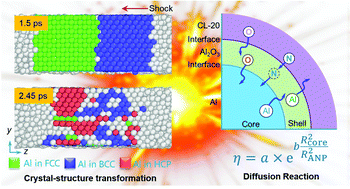Reaction mechanism of aluminum nanoparticles in explosives under high temperature and high pressure by shock loading†
Abstract
Aluminum nanoparticles (ANPs) can greatly improve the power of explosives. However, the rapid reaction mechanism of ANPs under simultaneous high temperature and high pressure by shock loading is not fully understood. In this study, a detonation wave was generated by impact of an explosive supercell on the reflect wall, and the reflected wave was eliminated by changing the end-boundary velocity. In this way, the problem of long time simulation under extreme pressure was solved and reaction molecular dynamics simulations of ANPs in explosives under shock or detonation were then performed with the ReaxFF force field. The results showed that the ANP crystal structure first transformed under shock loading, and diffusion oxidation of the ANPs then occurred. The reaction rate of the ANPs under high-temperature and high-pressure conformed to an exponential function of the pressure and oxide-shell thickness. Finally, the ANPs were stretched and disintegrated with expansion of the detonation products, which further accelerated ANP oxidation. A thicker oxide shell and a wax covering on the ANPs limited diffusion of the O and N atoms into the ANPs, which slowed down the oxidation reaction of the ANPs. A wax covering also prevented direct contact of the ANPs with the explosive, weakening the effect of the ANPs on the reaction of the explosive. This work is of great importance to deeply understand the reaction mechanism and energy-release law of aluminized explosives.



 Please wait while we load your content...
Please wait while we load your content...